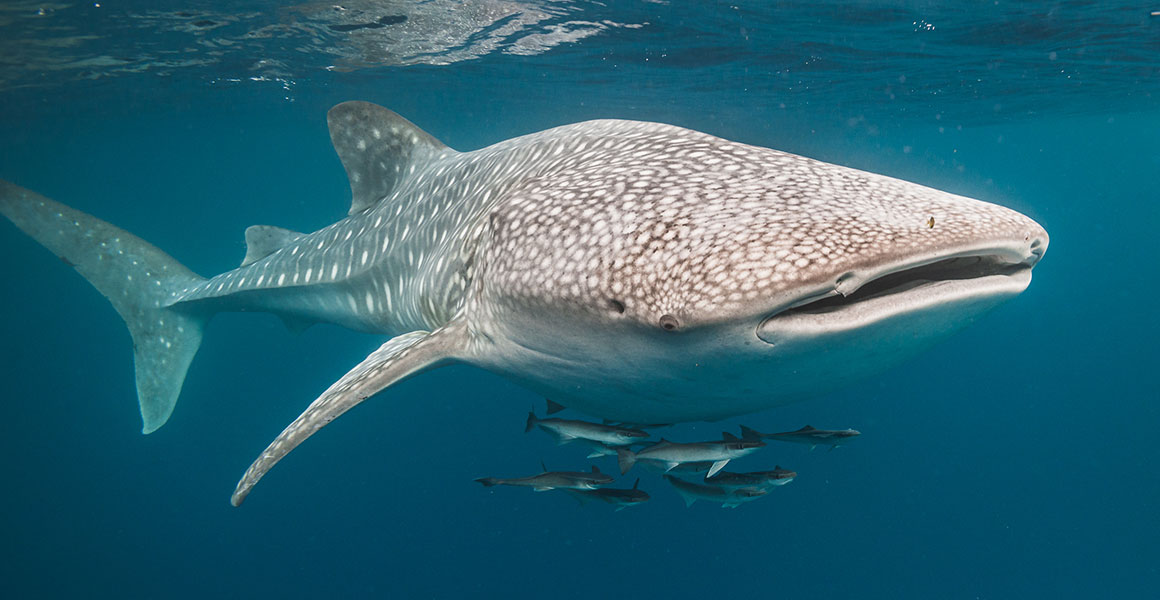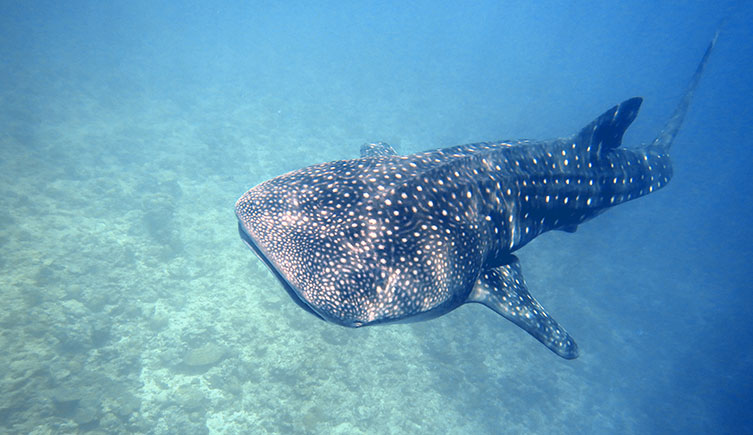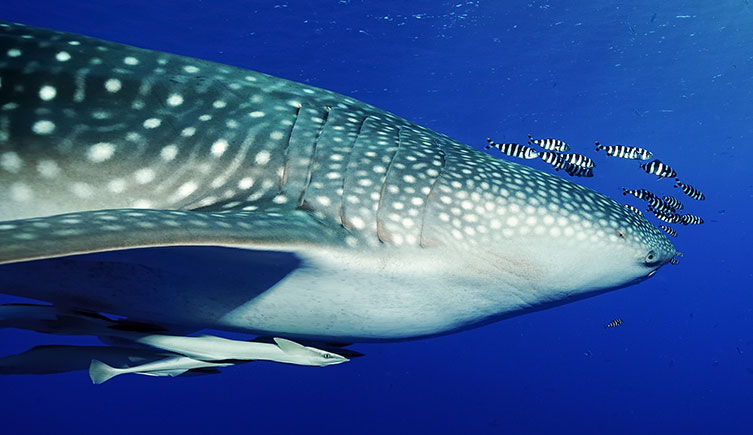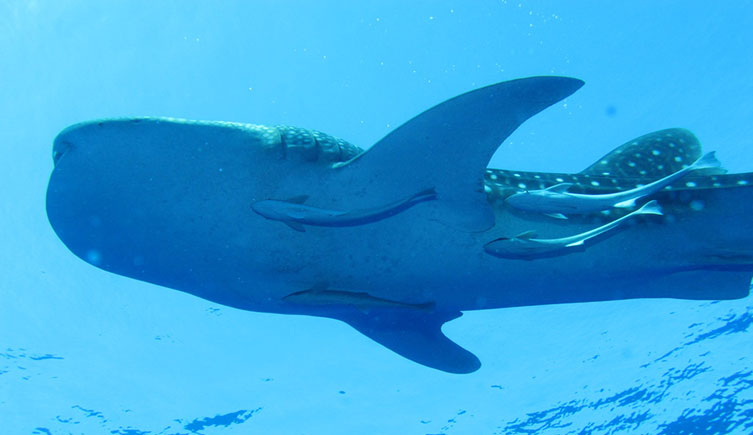When you think of giant sharks, the great white from the blockbuster Jaws is probably what springs to mind.
But at a little over six metres long, this fictional man-eating monster is small fry when compared to the world’s largest shark.

The whale shark is the largest fish in the world © Aaronejbull87/ Shutterstock
When you think of giant sharks, the great white from the blockbuster Jaws is probably what springs to mind.
But at a little over six metres long, this fictional man-eating monster is small fry when compared to the world’s largest shark.
Sharks are a group of fish with skeletons made from cartilage instead of bone. There are more than 500 species of shark found across the world, and they range in size from centimetres long to ocean giants.
Read on to find out about the biggest sharks in the world.
The whale shark, Rhincodon typus, is the largest fish in the world. It’s found in tropical and temperate oceans, in both deep water and coastal areas. It’s estimated that 75% of the whale shark population lives in the Indo-Pacific Ocean – which comprises the Indian Ocean, the western and central Pacific Ocean and the seas around Indonesia that connect the two. The Atlantic Ocean is home to the remaining 25% of the whale shark population.
Upon reaching sexual maturity, whale sharks are typically about nine metres in length. Many grow larger than this – with most of those measured coming in at around 12 metres.
However, they can grow even longer. One of the biggest whale sharks ever reported was an impressive 18.8-metre-long female from the north-western Indian Ocean – that’s longer than a tenpin bowling lane.

Whale sharks reach maturity at nine metres long. They can grow longer than this, but we don’t actually know just how much bigger they can get. © Jule Buschmann/Shutterstock
We don’t actually know the maximum size limit for these animals. There have been accounts of whale sharks measuring in at over 20 metres in length – though some scientists question the accuracy of these reports given the limited information on how the measurements were taken.
Accurately determining the size of large animals like whale sharks can be tricky. Measurements may be taken by comparing the animal to the size of a boat or snorkeler, or by swimmers holding up a tape measure or rope knotted at intervals beside the animal. Methods like these can result in errors, with one study finding that visual assessments tend to lead to underestimations for sharks more than eight metres long.
It’s also possible to calculate the length of a whale shark by using measurements of certain parts of its body and inputting these into mathematical formulas. Scientists may use this approach to remove some of the error that could be introduced by trying to measure the full nose-to-tail length of the animal as it moves through the water.
While the whale shark is certainly a big animal, it’s considerably smaller than the blue whale, Balaenoptera musculus, which is the biggest animal in the world. The largest blue whale ever recorded measured a staggering 33 metres in length. Some think that the whale shark’s cartilaginous skeleton may prevent it from reaching larger, blue whale-like proportions.

Whale sharks are gentle giants and only eat tiny planktonic organisms. © kaschibo/ Shutterstock
Whale sharks are the world’s largest shark, but only just – they have some relatively stiff competition. At 12.3 metres long, the basking shark, Cetorhinus maximus, comes in a close second. Then there’s the Greenland shark, Somniosus microcephalus, at 6.4 metres long and the great white shark, Carcharodon carcharias, at around 4.0 metres long, though there have been a few reports of individuals over six metres long.
For comparison, our giant squid Archie measures in at 8.62 metres long.
Despite their enormous size, whale sharks eat tiny planktonic organisms, including copepods, arrow worms, fish eggs, crab larvae, coral spawn and krill. Whale sharks are known for being gentle giants and humans are not on the menu. In fact, their gentle nature along with the algae found in their stomachs led some to mistakenly believe that they survived “entirely on vegetable food”.
Whale sharks migrate thousands of kilometres and will gather in large numbers at the same sites year after year to take advantage of seasonal fish spawning events and zooplankton blooms.
Like baleen whales, whale sharks are filter feeders. They can either actively suck food into their mouths or use passive ram filtration – where they slowly swim open-mouthed through patches of food. They use their gill rakers to sieve food particles out and swallow them while the water is expelled through their gills. A 6.2-metre-long whale shark swimming at around one metre per second would be able to filter about 614,000 litres of sea water per hour.
Despite not needing razor-sharp teeth for cutting and tearing their food, whale sharks still have rows and rows of tiny teeth that are an evolutionary hangover.
Whale sharks have to eat a lot to sustain their large bodies, but food supplies can be scarce in warm oceans. As a result, to survive, whale sharks must be energy efficient, for example, they’re very slow swimmers, rarely travelling at more than five kilometres per hour.
Whale sharks follow their planktonic prey as it migrates down into deeper water during the day – often diving to depths of 500 metres, with the deepest recorded dive being 1,928 metres. They are negatively buoyant, which means they are denser than the water around them. Negative buoyancy allows whale sharks to glide down to deeper water without using much energy.
Whale sharks are ovoviviparous, which means the eggs hatch inside the female’s body and the young are then born as miniature adults.
Of all the egg-producing sharks, whale sharks produce the largest eggs. The biggest whale shark egg ever recorded was found in the Gulf of Mexico in 1953 – it was more than 30 centimetres long and contained a 35-centimetre-long embryo.
Whale shark numbers are decreasing rapidly and the species is now endangered. While there is no accurate estimate for the size of the population, data suggests that the global population has declined by around 50% in the last 75 years.

Most of the threats whale sharks face are linked to human activity. Even tourism may disturb these ocean giants. © atiana Nurieva/ Shutterstock
Whale sharks face major pressures from human activity. Like other sharks, they have been targeted for their meat and fins. For example, in Taiwan the popularity and price of whale shark meat shot up in the late 1980s, reaching around £11 per kilogram in 1997. Local population depletion might have been why catches began to decline after this peak. In 2014, an undercover investigation found that a factory in south-eastern China had been illegally slaughtering at least 600 whale sharks a year, as well as other protected species, including great whites and basking sharks.
In many regions, there are now bans in place to protect whale sharks from being intentionally caught. They are also protected by regulations implemented by the Convention on International Trade in Endangered Species (CITES), though some illegal trade may still occur.
Whale sharks can get caught up in fishing nets in their feeding areas and migration corridors, and are also vulnerable to getting hit by ships. The activities of the multimillion-dollar whale shark tourism industry might also disturb these gentle giants.
On top of these pressures, marine pollution is also affecting this species. Studies have shown whale sharks are ingesting microplastics as they feed. Important whale shark feeding grounds have also been seriously impacted by the 2010 Deepwater Horizon oil spill. During this disaster, 4.9 million barrels, approximately more than 780 million litres, of oil leaked into the Gulf of Mexico, where whale sharks were seen swimming. This oil entered the food chain through planktonic organisms, which whale sharks may have eaten. Oil can also clog a shark’s gills, suffocating the animal.
Whale sharks likely play an important role in the ecosystem. Not only are juveniles an important prey for marine predators, but research suggests that whale sharks might be important for helping to move nutrients from productive coastal regions into nutrient-poor areas.

Whale sharks provide a habitat for fishes, such as remora. © Derek Keats via Flickr (CC BY 2.0)
During their lives, the bodies of whale sharks provide a habitat for parasites and remora fish. When they die and eventually sink, they may function like a whale fall, providing a rare source of food for seafloor-dwelling animals.
We have a lot left to learn about these enigmatic ocean giants. Unfortunately, despite protections being in place around the world, whale sharks are still under threat, mostly from human activities.
Discover more about the impact we’re having on our planet and what you can do to help.

Just how weird can the natural world be?
Don't miss a thing
Receive email updates about our news, science, exhibitions, events, products, services and fundraising activities. We may occasionally include third-party content from our corporate partners and other museums. We will not share your personal details with these third parties. You must be over the age of 13. Privacy notice.
Follow us on social media